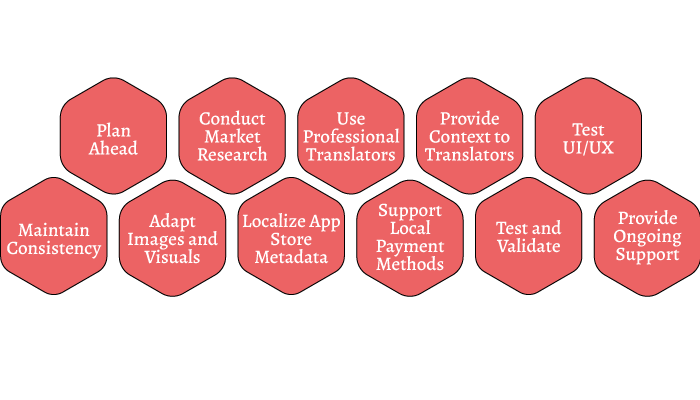Even in the age of globalization, mobile app localization still has its own value.
People have more than one way of understanding each other, especially when most of us speak or at least understand English. Thus, making it the official language of IT industry.
However, it still hasn’t replaced people’s love for their local language and culture. So, what this means for corporates and companies who are running larger platforms via mobile apps?
This means, to tap into the full potential of the market, they need to localize their app, bringing us to the concept of mobile app localization.
In this blog, we shall be discussing all you need to know about mobile app localization as well as best practices related to the same. So, with this being said, let’s get right into it:
What is Mobile App Localization?

The term “Mobile app localization” refers to the process of adapting a mobile application to meet the linguistic, cultural, and technical requirements of a specific target market or region.
It involves translating and modifying the content, user interface, and functionality of an app to make it more appealing and accessible to users in different countries or language communities.
This process is often not part of mobile app development. Regardless, it is very important for various reasons. Let’s discuss this in next section of the blog.
Why Is It Important?

So, why is mobile app localization so important?
Well, there are more than one reason. And in this section of the blog, we shall be discussing them in detail. These are, as mentioned below:
Expanded User Base
By localizing your app, you can reach a wider audience in different countries or language communities.
When people can use your app in their native language, it enhances the user experience and increases the chances of app adoption and engagement.
Improved User Experience
Localization allows users to interact with your app in a familiar and comfortable way. It shows that you value their language and culture, leading to a positive user experience.
This, in turn, can boost user satisfaction, retention, and word-of-mouth recommendations.
Increased App Downloads and Revenue
A localized app has a higher likelihood of being discovered and downloaded by users in various regions.
Thus, it can lead to increased visibility in app stores and improve your app’s rankings, resulting in more downloads and potential revenue from in-app purchases or subscriptions.
Competitive Advantage
In many markets, the availability of localized apps is considered a standard expectation.
By localizing your app, you gain a competitive edge over similar apps that are only available in one language.
Localization can differentiate your app and make it more appealing to users, helping you stand out in a crowded market.
Cultural Sensitivity
Localization ensures that your app respects and aligns with the cultural sensitivities, customs, and preferences of different regions.
It helps you avoid potential pitfalls, such as unintentional offensive content or misunderstandings, which can harm your app’s reputation and user trust.
Global Branding and Recognition
Localizing your app demonstrates your commitment to global expansion and strengthens your brand’s presence in different markets.
It allows you to establish a consistent brand identity across various languages and regions, fostering brand loyalty and recognition.
Localization as a Business Strategy
Successful localization can open doors to new business opportunities, partnerships, and collaborations.
It enables you to tap into emerging markets and establish relationships with local stakeholders, leading to potential business growth and expansion.
With this out of the way, let’s discuss best practices for mobile app localization in the section below.
Mobile App Localization Best Practices

Goes without saying, mobile app localization isn’t enough for everyone doing it. If you want to benefit from it, you need to localize your mobile app the perfect way!
In order to do that, there are some things that you need to do right. So, let’s look at best practices for mobile app localization.
Plan Ahead
One of the best mobile app localization advice anyone can give you is, to plan ahead.
More often than not, iOS or Android mobile app localization isn’t included in the development process. However, it should be.
You should incorporate localization into your app development process from the beginning.
This will help you identify potential localization challenges, allocate resources, and streamline the localization workflow. And trust us, it saves a lot of trouble for you in the long run.
Conduct Market Research
Market research is one of the most important elements of any app development project.
Here, you should gain a deep understanding of the target market’s culture, language preferences, and user behavior.
This knowledge will guide your localization efforts and ensure that your app resonates with the local audience.
Trust us on this one, knowledge gained here, will be very beneficial in the long run, and that’s why people invest a lot of money in this step of mobile app localization.
Use Professional Translators
Well, there are various tools on the internet that will translate one language to another, quite effectively.
While translation can be quite accurate, it can lose context. That’s why you should engage native-speaking translators who are experienced in mobile app localization.
They possess the linguistic and cultural expertise needed to accurately translate and adapt your app’s content.
Provide Context to Translators
One of the most important mobile app localization practices is, providing context to the personal whole will by translating your app’s content.
When Offer translators comprehensive information about your app, including its purpose, functionalities, and target audience, it can help them create accurate translations.
Thus, not leaving room for assumptions or speculations.
Test UI/UX
Mobile app localization’s scope expands much beyond changing language. To accommodate people of said local area, you need to make some changes in UI/UX designing.
Localization can impact the app’s user interface (UI) and user experience (UX).
Test the localized app extensively to ensure that the UI remains intuitive, and the UX is seamless across different languages and regions.
Maintain Consistency
Consistency is the key to success even in the case of mobile app localization.
Therefore, it’s highly recommended that you maintain consistent terminology, tone, and style throughout the app to create a cohesive and professional user experience.
This consistency helps users navigate the app and build familiarity with your brand. This is something that you should keep in mind when you localize mobile apps.
Adapt Images and Visuals
Images and visual elements play a crucial role in app localization.
Replace culturally sensitive or irrelevant visuals with localized alternatives that resonate with the target audience and align with their cultural norms.
Localize App Store Metadata
Translate and optimize the app’s metadata, including its title, description, keywords, and screenshots, in app stores.
This optimization improves the app’s discoverability and increases its chances of being downloaded by users in the target market.
In fact, this is something that you should keep in mind when you publish the android app in the Google Play store.
Support Local Payment Methods
It is no secret that in 2023, we are all using payment solutions to the full extent. In fact, it has come to the point where it is about to replace traditional cash.
However, not all areas are using mobile payment technologies.
Therefore, when it comes to mobile app localization, you should incorporate local payment options and currencies that are commonly used in the target market.
This enables seamless transactions for users, eliminating barriers to making purchases within your app.
Test and Validate
Thoroughly test the localized app to ensure that it functions properly, the translations are accurate, and the app aligns with cultural sensitivities.
Conduct mobile app localization testing to gather feedback and make necessary improvements. It is only through a test of the app that you can attain true perfection and thus, opening doors to new opportunities.
Provide Ongoing Support
Localization is an ongoing process, much like creating a successful mobile app itself.
Continuously update and support the localized app by addressing user feedback, fixing issues, and making improvements to enhance the user experience.
So, with this out of the way, it’s time to answer another big question, what is the cost of mobile app localization in the section below.
Average Cost of Localizing A Mobile App

Mobile app localization refers to the process of changing an app to accommodate a specific region i.e. “locality”.
Depending on the localization target, the process can differ highly. For instance, a particular project might just require a few language changes to the content while another might require a complete change in the UI/UX design of the platform.
Therefore, based on that, the price can highly differ. In any case, if you want to know the mobile app localization cost for your particular project, we highly recommend that you consult a mobile app development company like Nimble AppGenie.
Bottom Line
Mobile app localization can be the key to global success for the said platform. This is something that we often see in social media apps, eCommerce apps, as well as various other niches. Now, if you are someone who is interested in this concept, this blog did well to discuss basic information as well as best practices surrounding mobile app localization. And with this, we conclude our blog.
FAQ
While automated tools can provide a starting point, they often lack the accuracy and cultural understanding needed for high-quality translations. It’s recommended to involve professional translators for optimal results.
Conduct thorough market research to identify regions with high potential demand for your app. Consider factors such as user demographics, language prevalence, market size, and competition to make informed decisions about localization priorities.
It’s advisable to prioritize key target markets initially and gradually expand localization efforts based on user feedback, demand, and business objectives. This approach allows for better resource management and reduces potential risks.
Leave enough space in the app’s UI design to accommodate potential text expansion or contraction that may occur during translation. This ensures that the translated text fits properly within the UI without compromising readability or functionality.
Yes, adapting app features and functionalities to align with local preferences and requirements enhances the overall user experience and increases app adoption. It demonstrates your commitment to providing a tailored experience for users in different markets.
Regularly monitor user feedback, app performance metrics, and market trends to identify areas for improvement. Continuously update and optimize the localized app to meet evolving user needs and preferences.
The duration of the localization process depends on various factors, including the app’s complexity, the amount of content, the number of languages, and the availability of resources. It’s essential to allocate sufficient time for translation, testing, and iteration to ensure quality results.
While English is widely spoken, many users prefer apps in their native language. Localizing your app can significantly enhance user engagement, increase downloads, and open up opportunities in non-English speaking markets.
Localization often involves adjusting the design and layout of the app to accommodate different languages’ characteristics. Text expansion or contraction may require adapting the UI elements to ensure a visually appealing and functional user interface.
Cultural sensitivity is crucial to avoid offending or alienating users. Work closely with professional translators who understand the cultural nuances of the target market, and conduct cultural reviews of the localized content to ensure appropriateness.
Challenges may include maintaining UI consistency, ensuring accurate translations, managing text expansion, adapting to different cultural norms, addressing technical limitations, and coordinating with a distributed team. Thorough planning and collaboration can help overcome these challenges.

Niketan Sharma is the CTO of Nimble AppGenie, a prominent website and mobile app development company in the USA that is delivering excellence with a commitment to boosting business growth & maximizing customer satisfaction. He is a highly motivated individual who helps SMEs and startups grow in this dynamic market with the latest technology and innovation.
Table of Contents












No Comments
Comments are closed.